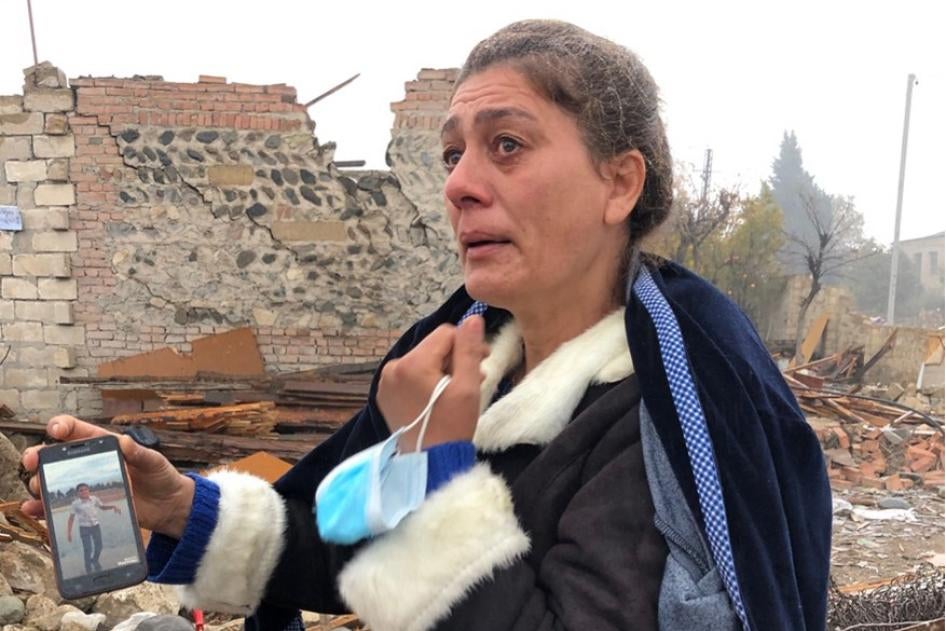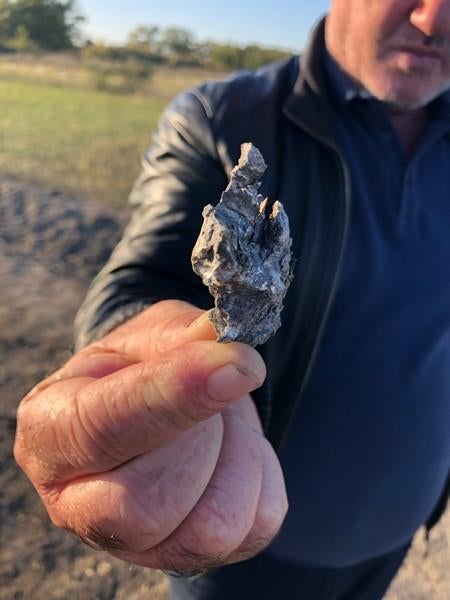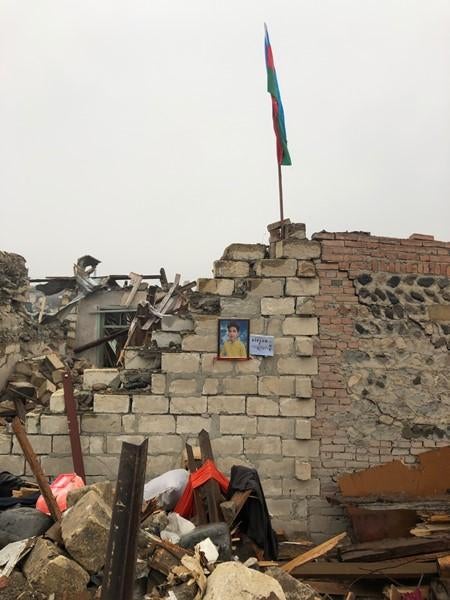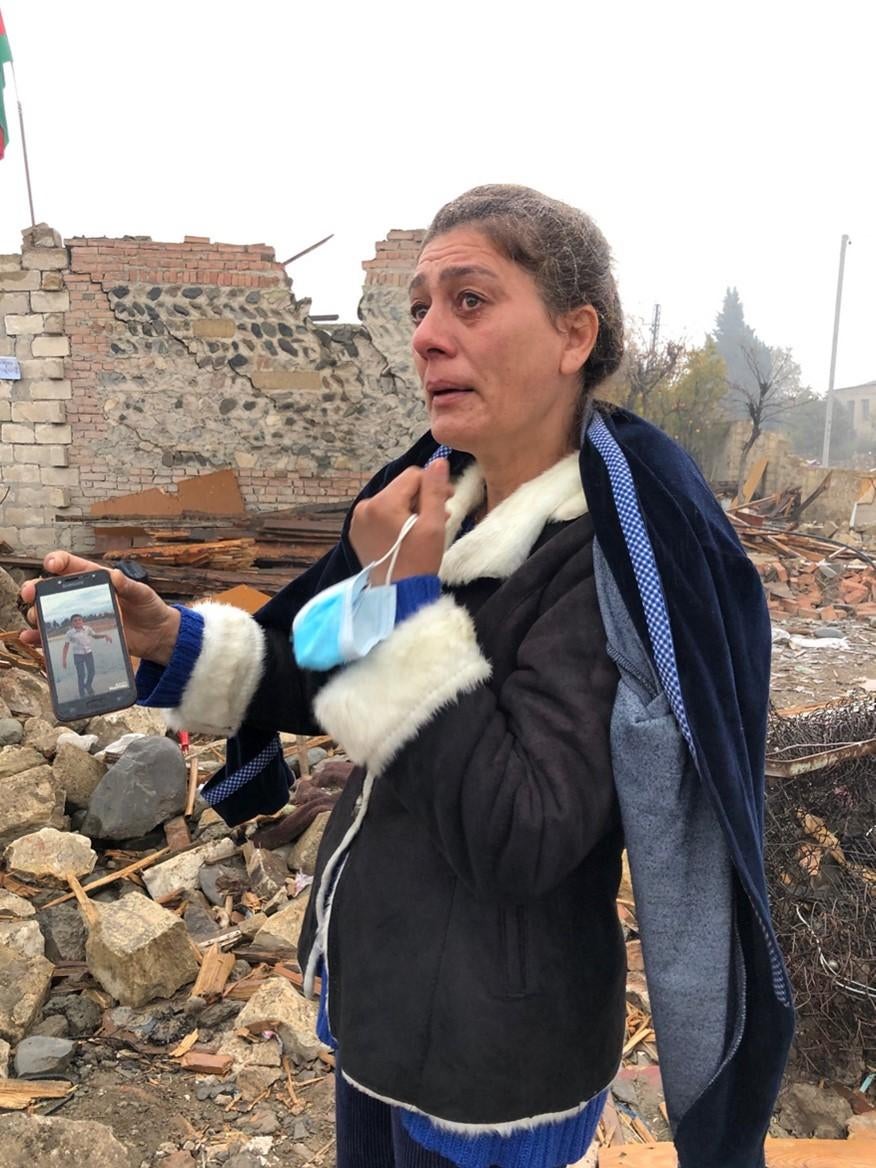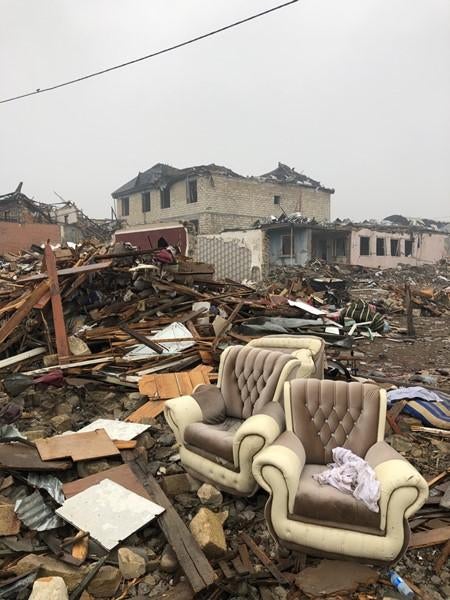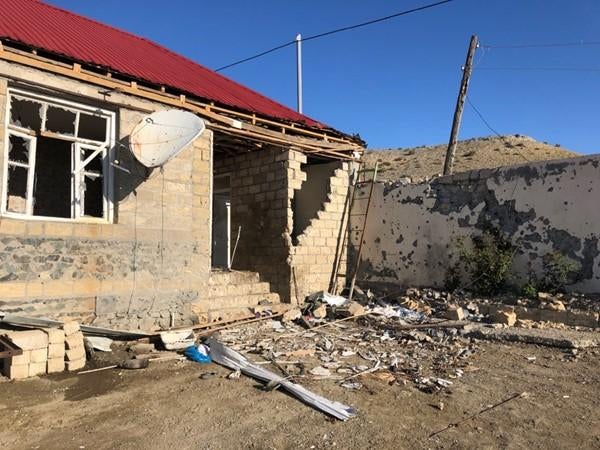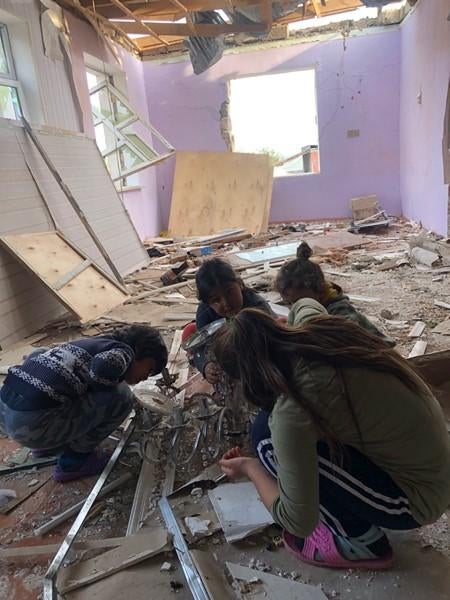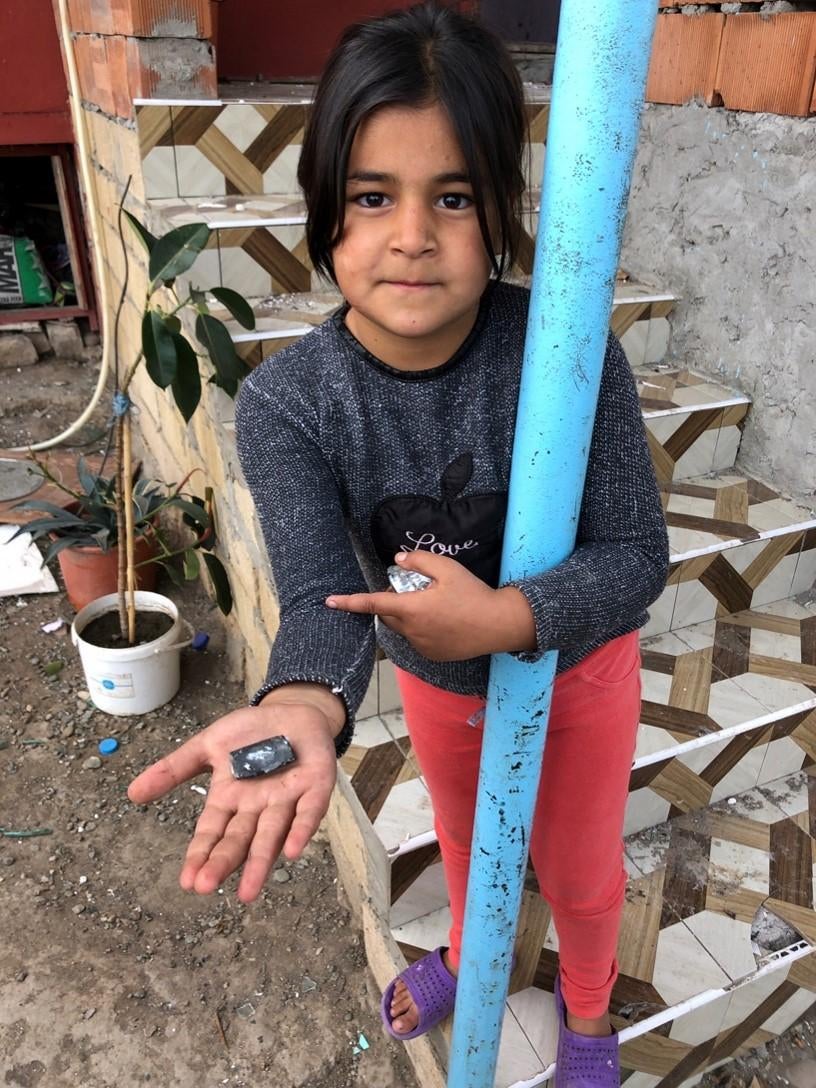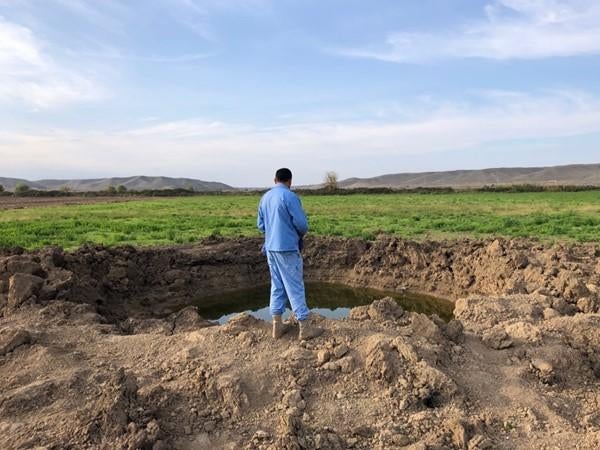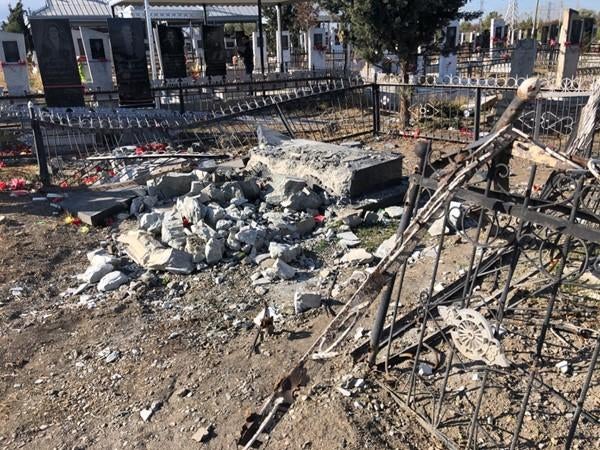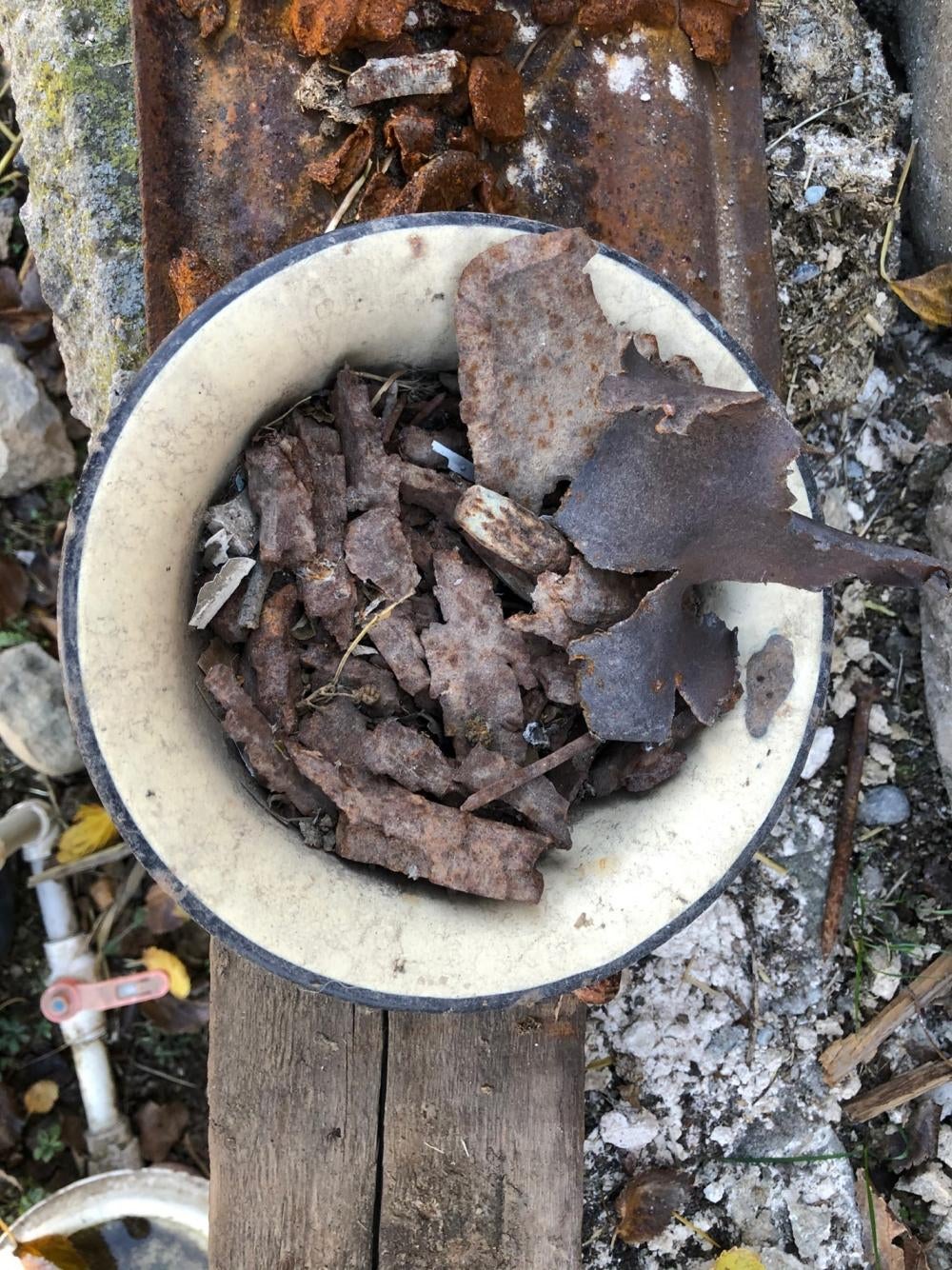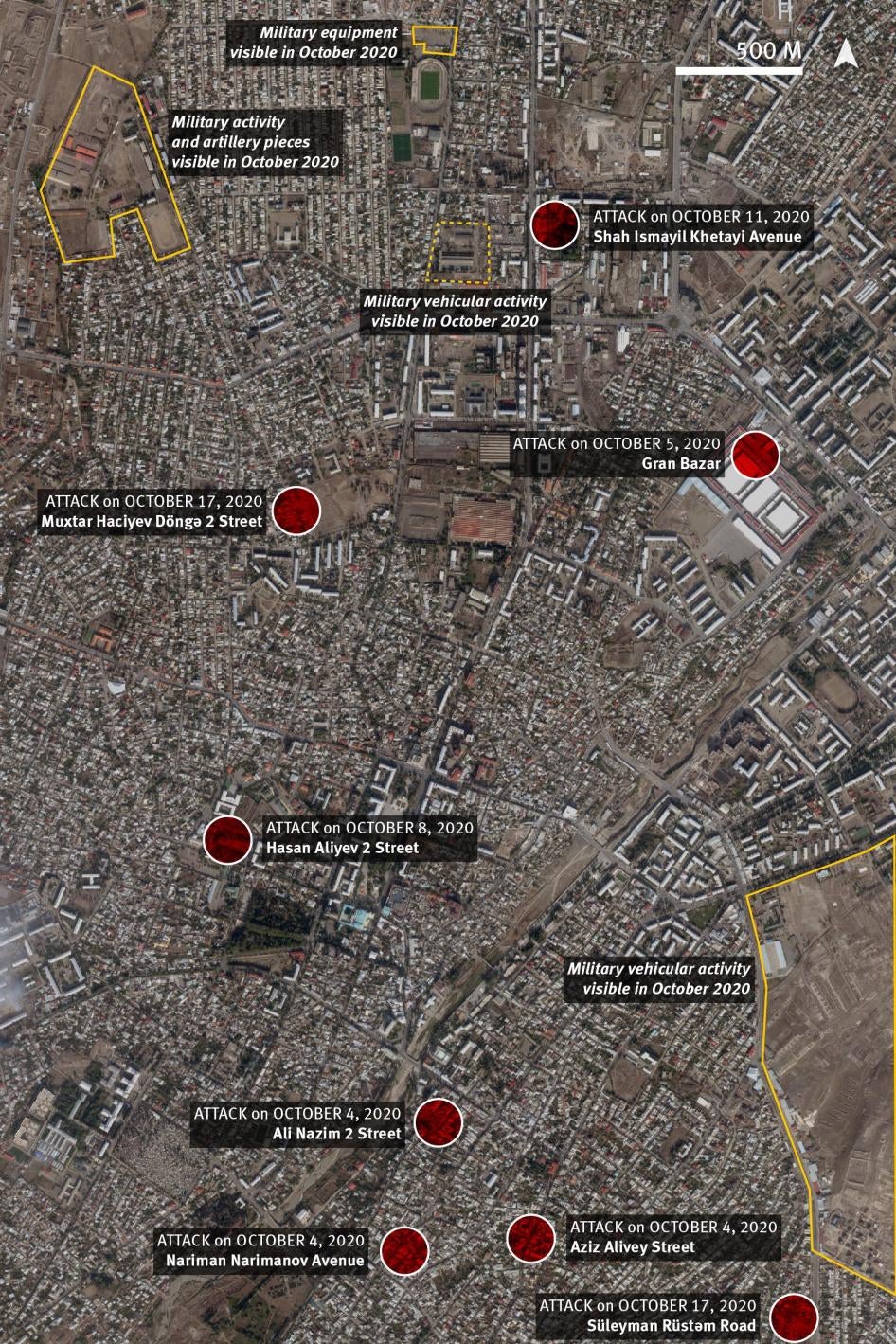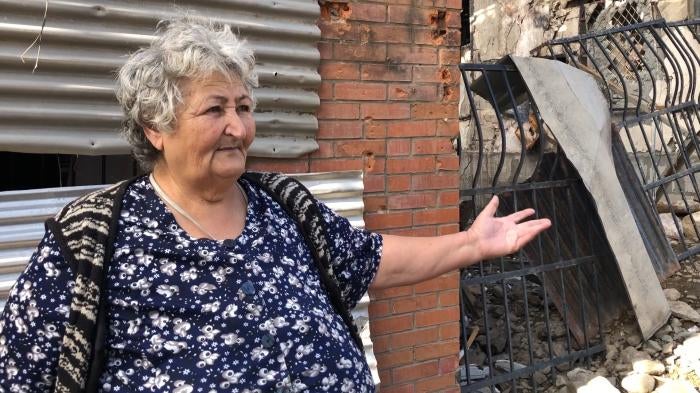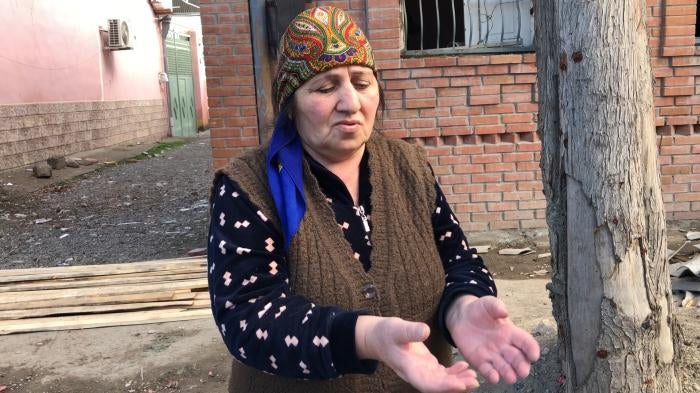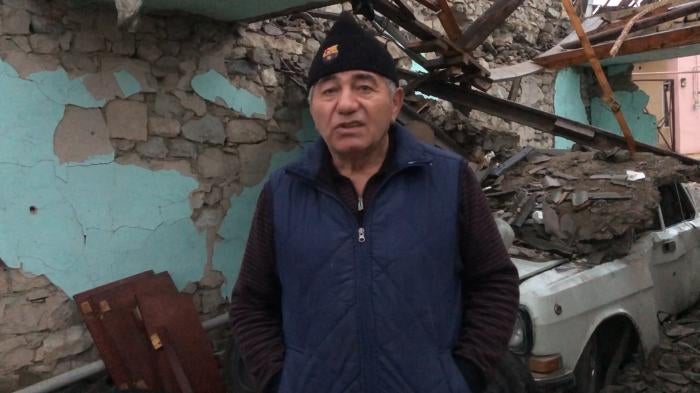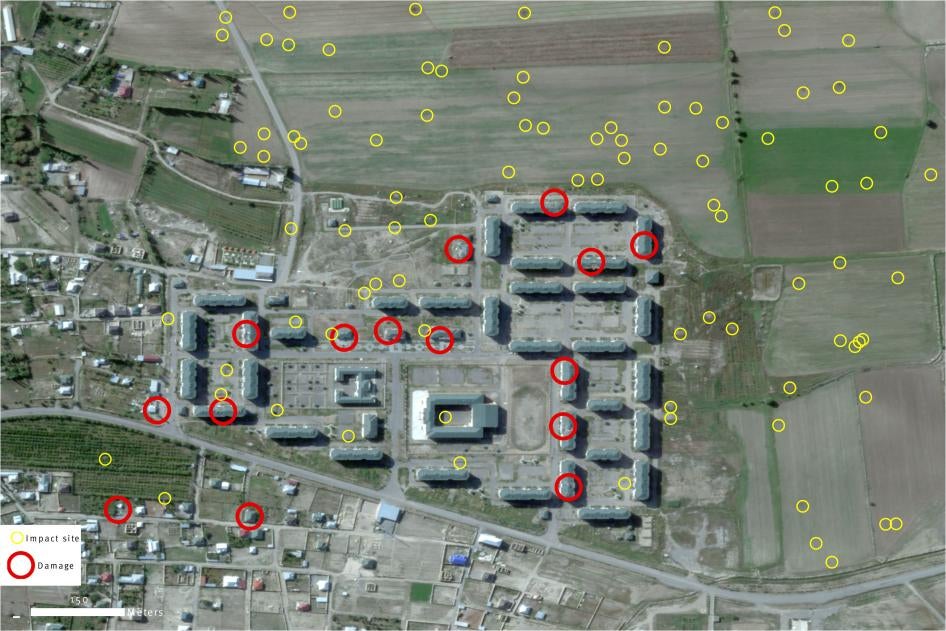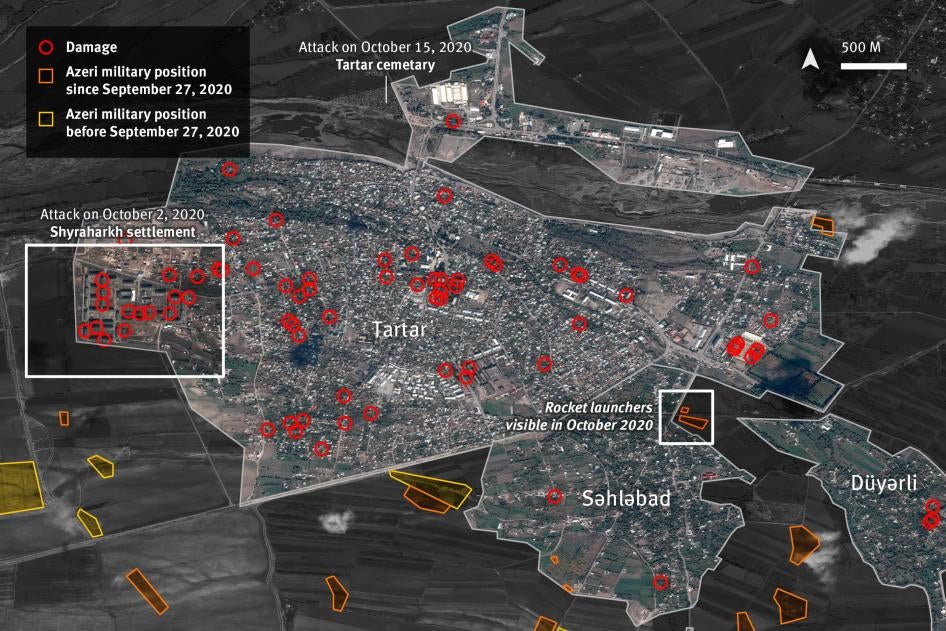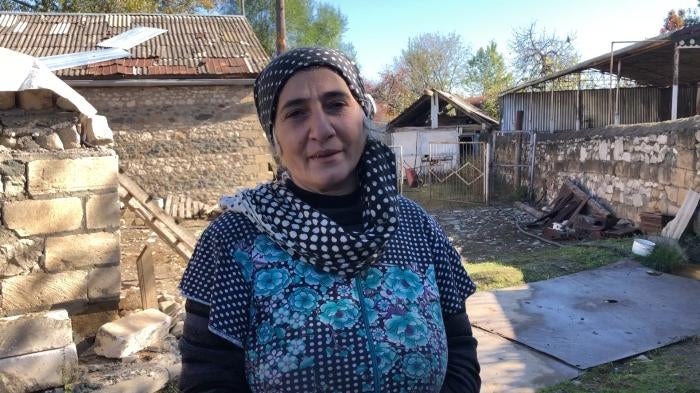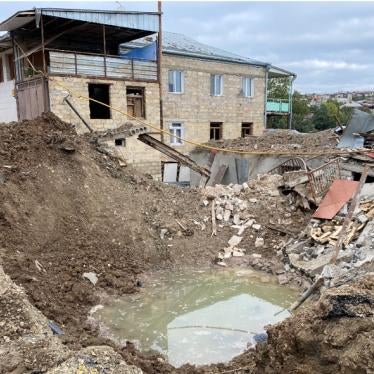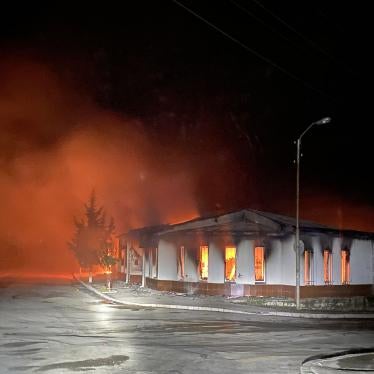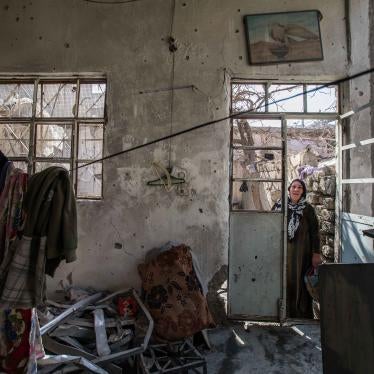(Berlin) – Armenian military forces carried out unlawfully indiscriminate rocket and missile strikes on Azerbaijan during the hostilities from September to November 2020, Human Rights Watch said today.
During on-site investigations in Azerbaijan in November, Human Rights Watch documented 11 incidents in which Armenian forces used ballistic missiles, unguided artillery rockets, and large-caliber artillery projectiles that hit populated areas in apparent indiscriminate attacks. In at least four other cases, munitions struck civilians or civilian objects in areas where there were no apparent military targets.
“Armenian forces repeatedly launched missiles, unguided rockets, and heavy artillery into populated cities and villages in violation of the laws of war,” said Hugh Williamson, Europe and Central Asia director at Human Rights Watch. “Again and again in the course of the six-week war, these attacks unlawfully destroyed civilian lives and homes and should be impartially investigated.”
Fighting between Azerbaijan and Armenia escalated on September 27 and continued until November 10, when the prime minister of Armenia and presidents of Azerbaijan and Russia concluded an agreement to end the hostilities.
Human Rights Watch investigated missile, rocket, and artillery attacks by Armenian forces that struck cities, towns, and villages in Aghdam, Barda, Fizuli, Ganja, Goranboy, Naftalan, and Tartar in Azerbaijan. This report examines 18 of these strikes, which killed 40 civilians and wounded dozens more, based on in-person interviews with 53 witnesses to attacks and 12 phone interviews, news reports, and governmental data. Human Rights Watch could not determine the lawfulness of three of the 18 attacks.
Human Rights Watch also examined satellite imagery of 10 of the 17 attacks and photos and videos posted on social media from the site of nine of the attacks, which corroborated the time and date of the attacks, and the scale of destruction. Other attacks will be addressed in future reports.
Satellite imagery revealed that Azerbaijan military forces were present in the cities of Ganja and Tartar and the villages of Gashalti and Tapgaragoyunlu, which Armenian forces attacked. Azerbaijan unnecessarily put civilians at risk by locating military objectives within or near densely populated areas and failing to remove civilians from the vicinity of military activities, Human Rights Watch said. However, the presence of military objectives did not permit Armenia to use inherently inaccurate explosive weapons with a large destructive radius in populated areas.
The governmental Azerbaijan National Agency for Mine Action (ANAMA) found that unguided Smerch artillery rockets and Scud-B ballistic missiles were used in attacks on Ganja between October 4 and 17, killing 32 civilians. Scud-B missiles, which can carry a 985-kilogram, high-explosive warhead, can miss their intended target by at least 500 meters. Attacks using weapons that cannot be directed at a specific military objective and so do not distinguish military targets from civilians and civilian objects, are indiscriminate, violating the laws of war.
In addition to causing civilian casualties, the Armenian attacks damaged homes, businesses, schools, and a health clinic, and contributed to mass displacement. According to the Azerbaijani prosecutor general’s office, 98 civilians were killed and 414 wounded during the armed conflict, and over 3,000 homes and 100 apartment buildings were destroyed or damaged. Azerbaijani government officials told Human Rights Watch that fighting displaced 40,000 people. Residents from conflict-affected areas that Human Rights Watch visited said that many people, especially women and children, had fled to safer areas.
The laws of war require attackers to issue effective warnings of attacks affecting civilians unless circumstances do not permit. Witnesses to attacks said they were not aware of warnings from Armenian or local Nagorno-Karabakh forces. On October 4, Arayik Harutyunyan, the Nagorno-Karabakh president, issued tweets in English calling on civilians “to avoid inevitable loss” by leaving “large cities,” including Ganja, where military forces would be attacked. Threats of attacks on unspecified targets over an unspecified period, in a language few Azerbaijani civilians can read, were not effective warnings.
Human Rights Watch previously reported Armenian attacks on Barda on October 28 that killed 21 civilians and wounded 70, and documented Azerbaijan’s use of cluster munitions in at least four incidents in Nagorno-Karabakh as of October 23.
The Armenian government should conduct impartial, thorough, and transparent investigations into attacks by Armenian forces that appear to violate international humanitarian law, or the laws of war.
States are currently in the process of negotiating a political declaration that would commit them to refrain from using explosive weapons in populated areas. Azerbaijan and Armenia should endorse such a political declaration, Human Rights Watch said.
“Armenian forces fired hugely destructive, inaccurate weapons into Azerbaijan’s cities, towns, and villages,” Williamson said. “Accountability for these and other apparent violations of the laws of war by both sides is critical if the region is ever going to move beyond this vicious, decades-long conflict.”
For details of the attacks and violations of the law of war, please see below.
September 27 Attack in Naftalan District
On September 27, between 5 p.m. and 6 p.m., an Armenian artillery attack killed five members of the Gurbanov family, all civilians, and damaged several homes in Gashalti, Naftalan district, three witnesses said. The village has approximately 1,200 residents. The attack hit Nadir Gurbanov’s home and killed his father, Elbrus, 69, mother, Shefiyat Gurbanova, 64, wife, Afag Amirova, 39, a niece, Fidan Gurbanova, 14, and his son Shariyar, 13. His one surviving son is attending secondary school in Baku.
Nadir, 41, a military serviceman, was stationed with his regiment about three kilometers away. “I saw one shell land near my house, and another shell a minute or two later, so I rushed home to check,” he said.
Nadir’s cousin, Mohammad Mammadov, said he arrived at the house to see Nadir hugging pieces of children’s bodies. “It was impossible to recognize them,” he said. “They were charred and had been hurled in every direction by the blast.” Human Rights Watch examined the severely damaged house and found several munition remnants in the courtyard that were consistent with fragments of large-caliber artillery.
Nadir’s brother Nijat, 44, said that at the time of the attack, Nadir’s regiment was the military objective closest to the village. However, satellite imagery indicates a large area where military forces may have been deployed that extends from the southern boundary of Gashalti and along the eastern side of the road leading to Tapgaragoyunlu, six kilometers south.
Satellite imagery recorded on October 8 shows significant military activity in this area, including recently constructed trenches, fighting positions, earthen berms, tactical deployments, and the movement of military vehicles coming from the direction of the front line, just south of Tapgaragoyunlu, toward Gashalti.
Human Rights Watch was unable to determine the intended target. However, the use of large caliber artillery, which due to its inaccuracy is typically fired multiple times and produces blast and fragments over wide areas, renders an attack indiscriminate in populated areas.
October Attacks on Ganja
Armenian forces conducted attacks using ballistic missiles and rocket artillery that hit residential neighborhoods in Ganja, Azerbaijan’s second-most populous city, on October 4, 11, and 17, killing 32 civilians and injuring dozens more. In addition, rocket artillery attacks hitting Ganja’s Grand Bazar shopping mall on October 5, reportedly wounded three people who were hospitalized, and School Number 4 on October 8, which did not cause civilian casualties. These explosive weapons, which are inaccurate and have wide-area effects, are indiscriminate in populated areas.
Azerbaijani forces created military sites in Ganja without moving the population to safer areas, putting civilians at unnecessary risk. Satellite imagery revealed long-term military sites in the city and forces in populated areas in at least two cases close to the time of attacks. Satellite imagery also showed a large area abutting populated areas in southeastern Ganja with increased military vehicular activity in October. The edge of the military position is 270 meters from the site of a ballistic missile strike on October 17 on Suleyman Rustem primary road.
In an October 17 statement following two ballistic missile attacks early that day, the Nagorno-Karabakh Defense Army listed seven sites in Ganja that it said were military targets, without providing location specifics.
Ganja residents showed Human Rights Watch one of the listed locations, the Armed Forces General Staff Radio Technical Battalion, which they said had been closed before the latest hostilities. It is a few hundred meters from the areas Armenian forces attacked on October 4. Human Rights Watch was not able to verify whether the site was in operation at the time of the attack; it was not in operation during a visit on November 7.
Another listed site, an air force helicopter squadron base, is at the Ganja International Airport, 4.5 kilometers from the closest attack on October 17. While Nagorno-Karabakh local authorities announced they had destroyed Ganja’s “military airport” following attacks on October 4, Ganja International Airport is the only airport in the area, seven kilometers from the closest site attacked on October 4, and was not harmed in the fighting on either October 4 or 17.
Asked in a BBC interview why Armenian forces had attacked civilians in Ganja, Armenia’s then-foreign minister, Zohrab Mnatsakanyan, skirted the issue and instead cited deadly attacks by Azerbaijani forces on civilians in Stepanakert, Nagorno-Karabakh’s capital.
Attacks that use weapons that cannot distinguish between civilians and civilian objects and military targets, or that treat a number of separate and distinct military objectives in a city as a single military objective are indiscriminate.
October 4
At around 10:30 to 11 a.m. on October 4, Armenian forces launched three rockets that hit within a few hundred meters of one another in residential neighborhoods in Ganja, witnesses said. Human Rights Watch visited the three areas on November 7 and interviewed nine witnesses after speaking with three witnesses by phone in October. Human Rights Watch documented injuries to 18 civilians in these strikes.
Official Azerbaijani sources said the attacks killed one civilian, Tunar Aliyev, and wounded 32. On the basis of weapons’ remnants, and consistent with damage that Human Rights Watch observed and witness descriptions of the attack, ANAMA identified the attack as a barrage of Smerch rockets, which are indiscriminate weapons that should not be used in populated areas.
On Ali Nazmi Street, Human Rights Watch observed two destroyed residential buildings, one of them a multi-family structure, and about 30 damaged houses, and spoke to two residents who witnessed the attack. Taleh Asgarov said that flying glass and other debris injured six of his family members. His home and his brother’s house next door were severely damaged. Besti Khalilova, a pensioner, said in a phone interview that she, her son, daughter-in-law, and 1-year-old granddaughter were wounded. She shared by phone a photograph of her granddaughter’s head wound.
A second attack hit on Aziz Aliyev Avenue, where Human Rights Watch observed severely damaged homes and spoke to four witnesses. Gunduz Piira Tural, 31, said the attack destroyed his home, wounded his children and his mother-in-law, and left his wife, 26, unable to see. Gunash Kasimova, 66, said she heard a huge blast and ran into the street, saw that a house had caught fire, and helped drag a 4-year-old girl, Sara, and a baby, out of the house. Sara’s aunt, Seven Amirova, confirmed Kasimova’s account. Rahila Zargarova, 62, said she was having tea when she “heard a huge blast, and the ceiling and roof fell on [her] head.” Her head injury was visible when researchers interviewed her in November.
Armenian forces conducted a third strike that caused damage to a residential area on Nariman Narimanov Avenue. There, Human Rights Watch observed the destroyed home of Abbas Hasanov and his wife, Lala Hasanova, 31, and a crater in their backyard, and spoke to them and Hasanova’s father, Arif Aliyev, who was there during the attack. She said she and her two young children were injured. She heard two explosions and went to turn on the television news when a blast threw her into the living room, sent her daughter into another room, and covered her and her son in debris. She and her daughter suffered bruises and cuts and her son had broken arms and fingers, the family said.
October 11
At about 1:50 a.m. on October 11, Armenian forces fired a Scud-B ballistic missile that detonated in a residential neighborhood between Ganja’s parallel streets of Alakbar bay Rafibayli and H. Aliyev Avenue, killing 10 civilians and wounding 34 others, according to residents and official sources. Human Rights Watch observed a massive crater and more than 20 damaged or destroyed buildings in the area, behind a row of multi-story commercial buildings facing Aliyev Avenue, close to a small park.
Two witnesses, Akifa Bayramova, 63, and Shargiya Dashdamirova, 68, interviewed separately, said the explosion buried them and that they had to be pulled out of the rubble. Bayramova estimated that at least 60 families had lived in the buildings that were damaged or destroyed. Dashdamirova said she was still “covered in bruises” and had difficulty walking 10 days after the attack, when Human Rights Watch spoke to her. Her home was completely destroyed.
Saadat Alasgarova, 43, said the attack killed her brother-in-law, his wife, and their son, destroyed their two-story home, and killed seven other people.
ANAMA said that it recovered remnants of a Scud-B ballistic missile at the site. Based on images of the remnants tweeted by an Azerbaijan government official, an independent weapons analyst also identified it as a Scud-B.
Human Rights Watch analysis of satellite imagery taken between October 9 and 16 identified military weapons and equipment at sites 700 meters and one kilometer from the impact crater of the October 11 attack on Ganja; neither military site was damaged. Satellite imagery showed a third site, 200 meters from the October 11 attack, that contained transport vehicles. Human Rights Watch was not able to verify whether the site or the vehicles observed there were used to support military operations.
October 17
At about 1 a.m. on October 17, ballistic missiles hit two residential neighborhoods in Ganja, killing 21 civilians, including five who had died of their wounds after the attack as of November 6, according to residents and official sources.
One missile, which ANAMA identified as a Scud-B, hit the residential Mukhtar Hajiev Street. Human Rights Watch interviewed 13 residents who were at home at the time of attack, and observed 10 houses destroyed and over 20 damaged at the site. Shaira Guliyeva, 47, whose home was next to the impact crater said:
We found our neighbor’s leg in what used to be our kitchen. [Someone’s] intestines were found on a telephone wire. Two children were killed in a neighboring house – their bedroom was completely destroyed, so the family could not even recover the bodies.
Guliyeva said that her nephew, Arthur Guliyev, 13, had to be dug out after the attack and died a week later and that her sister, Gulnara, was seriously injured and remained in the hospital as of November 6. She said that flying debris also injured her and her mother.
Fakhriya Aliyeva, 20, whose house was destroyed, said her neighbors Zuleiha Shakhnazarova and Royal Shakhnazarov and their 16-month-old daughter Madina Shakhnazarli were killed, leaving their 3-year-old daughter in her grandparents’ care. Aliyeva said Madina’s “body was found under the debris of their house and her mother’s [severed] head was found in the courtyard.”
Timur Sarkarov said the explosion destroyed his father’s home, killing his father, sister, brother, and two nieces and leaving three survivors wounded and traumatized, including another brother, who lost his hearing.
Ramiz Gahramanov was home when the strike killed his daughter, daughter-in-law, and two grandsons, ages 6 and 11, and destroyed his two-story home. After the attack, he said he had to identify his family from pieces of their hair and body parts.
Mahir Bagirov, 55 and Bahar Bagirova, 53, had lived at their house with their daughter Ilaha Hamzayeva and her three children, ages 9, 7, and 2, when it was destroyed in the attack. Hamzayeva, 29, said that each night since the attack, she “cannot stop shaking” and her toddler “barely eats anything... [and] keeps saying ‘Mama, bomb.’”
Almost simultaneously with the attack on Mukhtar Hajiev Street, a second Scud-B missile hit the Avtozavod neighborhood on Suleyman Rustem primary road. The attack destroyed or left uninhabitable 15 family homes and damaged 40 to 50 others, residents said. Human Rights Watch observed a large crater and dozens of damaged or destroyed residential buildings and munition remnants scattered at the blast site on November 7, and other missile remnants at the ANAMA headquarters in Baku on November 4.
Human Rights Watch interviewed nine Avtozavod neighborhood residents, including Farhad Heydarov, 64, who showed his house with destroyed doors, windows, and roof and pointed out a building where he said a woman named Maral and her granddaughter were killed. Basti Jafarova, 62, said she was treated in the same hospital room where Maral died.
Jafarova’s 10 family members suffered cuts after the blast, which tore off their roof. Two members of the extended Mammadov family said that the explosion destroyed three homes where they and nine other family members lived, and killed two relatives, Elman Mammadov, 52, and his sister-in-law Aybaniz Mammadova, 40. Azad Jafarov, 30, said the explosion destroyed her house and embedded pieces of a plastic window frame in her body, causing “horrible pain.”
Satellite imagery showed a large area of military deployment with increased military vehicular activity during October that abuts residential areas in southeastern Ganja. The edge of the military site is 270 meters from the ballistic missile strike on Suleyman Rustem primary road.
September and October Attacks on Tartar District
Tartar City
Azerbaijan maintained a significant military presence in or near parts of the city of Tartar. Armenian forces frequently shelled the city throughout the conflict.
On September 28, the second day of fighting, a fragment of a shell that struck the main street in front of the Tartar District Court hit an ambulance and cut off the leg of the driver, Ganbar Asadov, 52. Another shell killed Mehman Aliyev, a 45-year-old civilian on the sidewalk about 20 meters from the courthouse. On November 8, Human Rights Watch observed damage to the area consistent with artillery shelling.
Satellite images show that new fighting positions, trenches, and military equipment were established after September 27, surrounding the southern and western parts of Tartar city.
During October, new tactical deployments emerged immediately adjacent to residential areas in Tartar and nearby towns. From October 8 to 23, the number of Azerbaijani artillery rocket launchers located near Tartar city increased from one to four.
Satellite imagery recorded on October 23 showed substantial damage and cratering from shelling throughout Tartar city during October. Hundreds of craters consistent with heavy artillery shelling were concentrated in the Shikharkh neighborhood, on the city’s western edge, comprised of multi-story residential buildings for people displaced by fighting in the 1990s. Specific satellite imagery of Shikharkh recorded on October 3 shows signs of an artillery attack, and a video uploaded to social media by a local resident on October 2, which Human Rights Watch viewed, shows an artillery attack on a kindergarten in the settlement that day.
While in Tartar city on November 8, Human Rights Watch observed severely damaged houses and shops on the main street, as well as numerous military vehicles.
October 15 Attack on Tartar City Cemetery
At around 12:45 p.m. on October 15, an Armenian forces strike hit a cemetery 400 meters north of Tartar, killing four civilians attending a funeral, Parviz Orujov, 31, Shakir Zamanov, 32, Vasif Rustamov, 60, and Iskandar Amirov, 53, witnesses said. Four men were injured.
Fizuli Mammadov, 54, who was wounded in the attack, said in a phone interview that they had gone to the cemetery to bury his aunt, who died of natural causes. He said that they were carrying her body to the cemetery entrance when they heard whistling overhead. They dropped the body to run for cover when a munition exploded about 50 meters away, and a few minutes later, another munition hit a grave nearby. Mammadov said he was injured in his back, leg, and left arm, which required surgery.
Rafael Gazanfarli, 34, a mullah who came from Goranboy for the burial, said in a phone interview that he was wounded in both legs and one of his kidneys by 11 fragments.
The witnesses said they did not observe any military targets in the vicinity of the cemetery at the time of the attack. Human Rights Watch visited the cemetery on November 8 and examined the damaged graves.
Barda District
October 28 Attack on Barda City
An Armenian strike hit Barda City at about 1:30 p.m. on October 28. Dr. Vusal Mammadov, 40, the director and chief surgeon of the Barda Treatment and Diagnostic Center, said he was working at the center when “everything turned dirt, dust, and soil, and [we] lost all the windows.” A fragment from a second explosion wounded a nurse, Ramziya Guliyeva, leaving her unable to move her legs and damaged dialysis machines, and shattered glass cut 22 patients and staff, Mammadov said.
Human Rights Watch observed damage to the clinic, severe damage to a State Migration Service office, and to the windows and concrete perimeter wall of a sports complex, consistent with an explosive weapon with wide area effects. Clinic staff showed Human Rights Watch researchers on November 9 remnants of unguided Smerch rockets that produce blast and fragmentation effects, which they said they had collected from the clinic’s grounds from the attack. The attack was apparently part of the Smerch rocket barrage at 1:30 p.m. on October 28, which Human Rights Watch previously documented, that killed 21 civilians and wounded 70, with cluster munitions and parachute-retarded high-explosive fragmentation rocket.
On October 29, the local Nagorno Karabakh Defense Army listed six sites in Barda as military targets, without providing locations.
November 7 Attack in Ayrija Village
On November 7, Armenian forces fired a rocket that struck an agricultural field near the village of Ayrija, and killed Shahmaly Rahimov, 16, as he was playing with other children. No other children were wounded. ANAMA identified the munition as a 9M528 Smerch rocket, which carries a warhead that produces blast and fragmentation effect.
Human Rights Watch visited the site and the place where Shahmaly’s relatives said he was killed, nearly 100 meters from the impact site. His uncles, Isa Rahimov, 65, and Gulmaly Rahimov, 58, said that no one else was wounded and that it was the only attack on Ayrija. When Human Rights Watch visited the small rural settlement two days after the strike, researchers did not observe any military objectives in the area.
Even if there was a valid military target, attacks that use weapons that cannot distinguish between civilians and civilian structures and military targets are unlawfully indiscriminate.
Goranboy District
October 4 and October 28 Attack in Tapgaragoyunlu Village
An artillery attack on October 4 at about 3:30 p.m. wounded Gumush Garayeva, 52. “Suddenly a wave lifted me and threw me against the wall,” she said. “A cloud of dust and smoke filled the room. I could not see anything. My left leg was bleeding.”
At about 5 p.m. on October 28, Armenian forces fired a munition that produced fragmentation and killed Flora Zahidova, 63, a civilian, while she was home alone, said Abbas Alaverdiyev, a village representative. Alaverdiyev said he found her body, with a severe head wound and a broken leg, in the covered courtyard behind her house. Human Rights Watch on November 9 observed substantial damage consistent with fragmentation at Zahidova’s home. The village, with 650 households, had 170 homes with various degrees of damage due to attacks, Alaverdiyev said.
While in Tapgaragoyunlu, Human Rights Watch observed a significant Azerbaijani military presence, including a large military base and numerous military trucks. Human Rights Watch could not determine the legality of the two attacks investigated.
October 1 Attack in Hajimammadli Village, Aghdam District
Armenian forces struck Hajimammadli village, in an agricultural area, at around 11 a.m. on October 1, residents and local news reports said. Two civilians, Murshud Mammadov, 54, and his son Samir Mammadov, 24, were killed in the courtyard of their home. Murshud’s cousin Ahliyat Mammadov, 42, said that Murshud’s wife, two other children, and his father had been staying elsewhere during the hostilities.
“It was just the two of them there,” Ahliyat Mammadov said. “I was in the bomb shelter nearby. And I ran to the location five minutes after the explosion and found the bodies.” He said it was the only attack on the village. The general prosecutor’s office said that the attack involved large-caliber artillery shelling.
Human Rights Watch found no evident military objectives when visiting the strike site on November 10.
October 5 Attack in Babi Village, Fizuli District
At about 1:45 a.m. on October 5, Armenian forces fired a munition that landed in a field about 500 meters from Babi, residents said. The village, with roughly 1,200 residents, is about five kilometers from the city of Horadiz, in Fizuli district.
Asuda Aliyeva, who was home with her husband and 8-year-old son, said: “We woke up from the loud noise. The electricity was out. The door, windows, and ceiling fell where we were sleeping. I don’t know how to describe it. We were so scared.”
Human Rights Watch, which visited the site on November 10, observed small remnants of a munition at the site of the crater. ANAMA identified the munition as a Scud-B ballistic missile and measured the crater as 15 meters in diameter.
An ANAMA official reported that at the time of the attack the nearest Azerbaijani military unit was seven kilometers away, in Cocuk Merjanli in the Jabrayil region. Human Rights Watch could not determine the intended target of the attack.
Relevant International Humanitarian Law Standards
International humanitarian law, or the laws of war, applicable to the international armed conflict between Azerbaijan and Armenia, prohibits deliberate attacks on civilians or attacks that are indiscriminate or cause disproportionate harm to civilians and civilian objects. Warring parties must take all feasible precautions to avoid or minimize civilian harm, including by refraining from deploying in densely populated areas.
Indiscriminate attacks strike military objectives and civilians or civilian objects without distinction. These include attacks that are not directed at a specific military objective or that use weapons that cannot be so directed. Prohibited indiscriminate attacks include area bombardment, attacks by artillery, or other means that treat as a single military objective a number of clearly separated and distinct military objectives in an area containing a concentration of civilians and civilian objects.
Military commanders must choose a means of attack that can be directed at military targets and will minimize incidental harm to civilians. If the weapons used are so inaccurate that they cannot be directed at military targets without imposing a substantial risk of civilian harm, then they should not be deployed.
While there is no general prohibition against the use of explosive weapons in populated areas, the use of weapons that are inherently indiscriminate, such as cluster munitions or unguided rockets, may invariably cause indiscriminate harm to civilians and civilian objects. Warring parties should avoid the use of explosive weapons with wide-area effects in populated areas due to the foreseeable civilian harm they cause, both at the time of attack and in the future, Human Rights Watch said.
Serious violations of the laws of war committed by individuals with criminal intent, deliberately or recklessly, are war crimes. Governments have a duty to investigate allegations of war crimes by members of their armed forces or forces on their territory and to fairly prosecute those found responsible.
